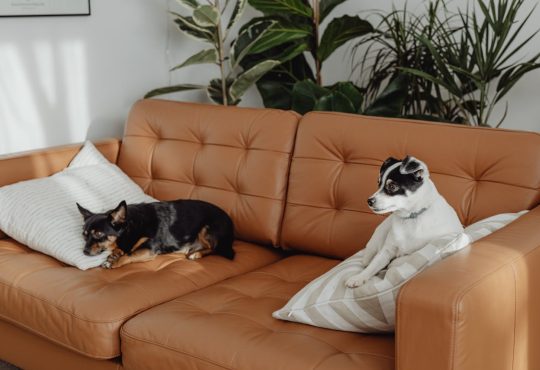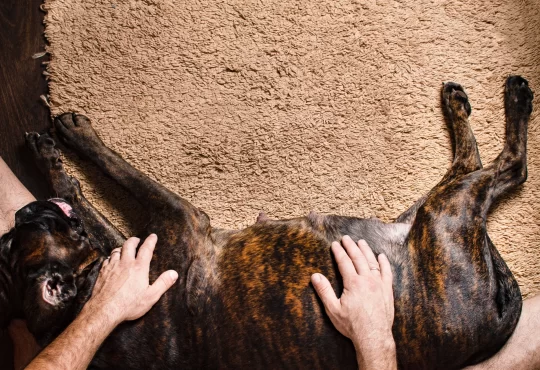If you’re asking yourself, “Why does my room smell like pee?” the answer usually comes down to one of three main reasons: hidden pet accidents, mold that smells like cat urine, or lingering odors in fabrics like carpets, curtains, or bedding. These smells can develop over time due to moisture, poor ventilation, or bacteria.
The good news is that this problem is solvable. First, you’ll need to find the source of the smell—whether it’s a hidden spot your pet used, damp areas that are growing mold, or something less obvious like your cleaning products.
Once you’ve pinpointed the cause, you can use proven cleaning methods like enzyme cleaners or natural solutions like baking soda and vinegar to eliminate the odor completely.
Common Reasons Your Room or House Smells Like Pee
If your room or house smells like pee, the first step is figuring out what’s causing it. Here are some of the most common culprits behind that unpleasant odor:
Hidden Pet Accidents
Even the best-trained pets can have accidents, and if these spots go unnoticed, they can leave a persistent pee smell in house. Carpets, rugs, and furniture can absorb urine, making the smell linger even after the surface seems dry.
If you don’t have a pet but notice your house smells like litter box but no cat, the culprit could still be urine from a previous tenant’s pet or outdoor animals sneaking into your space.
Mold That Smells Like Cat Urine
Believe it or not, some types of mold emit a smell similar to cat pee. If you’re wondering, “Can mold smell like cat pee?” the answer is yes! Mold thrives in damp and poorly ventilated areas, like behind walls, in basements, or under carpets.
This type of mold that smells like cat urine can be tricky to detect but often accompanies other signs of moisture, like discoloration or damp spots.
Lingering Odors in Fabrics
Soft materials like carpets, curtains, and upholstery can trap odors over time. If you spill something, sweat on your bedding, or have high humidity in your home, these fabrics can develop a smell that resembles urine. This is especially common in older homes where deep cleaning hasn’t been done regularly.
Bathroom Smells Like Cat Pee
Bathrooms are another hotspot for pee-like odors. Mineral buildup in toilets, damp towels, or even cleaning products that mimic the smell of ammonia can make the bathroom smell like cat pee. Regular cleaning and proper ventilation are essential to avoid this issue.
Poor Ventilation
If your room doesn’t get enough fresh air, odors can build up and become more noticeable. A lack of airflow can make even faint smells, like sweat or dampness, seem stronger. This is often why a house smells like urine even when the source isn’t obvious.
Unusual Sources of Pee Smell in the House
Sometimes the source of a pee-like smell isn’t obvious. Beyond common reasons like pet accidents or mold, there are a few surprising culprits that might make your house smell like urine. Let’s explore these less-expected sources:
Foods and Drinks That Impact Odor Perception
Believe it or not, what you eat or drink can affect how smells linger in your living space. Strong-smelling foods like asparagus or coffee can produce odors that resemble urine when they mix with sweat or bodily fluids absorbed by fabrics. If your room smells off and you can’t pinpoint why, think about what’s recently been consumed or spilled in the area.
Cleaning Products That Mimic Urine Smell
Certain cleaning products, especially those with ammonia, can leave behind an odor similar to cat pee. If you’ve recently scrubbed your bathroom or floors and now notice your bathroom smells like cat pee, the cleaner might be to blame. Switching to natural cleaning solutions like vinegar and baking soda can help.
Poor Ventilation and Humidity
When there’s not enough airflow in your home, moisture builds up, creating the perfect environment for smells to linger. This is often why a house smells like a litter box but no cat. High humidity can also encourage bacterial growth on surfaces like carpets and furniture, amplifying unpleasant odors.
Furniture or Electronics
Furniture and electronics can surprisingly hold onto odors. Wooden furniture, for instance, can absorb smells if exposed to moisture or spills. Similarly, electronics like old air conditioners or humidifiers can emit musty smells that resemble urine if they’re not regularly cleaned.
What Is My Fashion Style? Find Yours in 6 Steps

How to Identify the Source of the Pee Smell
If your room smells like pee or your entire house smells like urine, the key to solving the problem is identifying where the smell is coming from. While it might feel like a frustrating game of hide-and-seek, these steps will help you track down the culprit.
Start with Common Culprits
Begin by checking areas where accidents are most likely to happen, such as carpets, rugs, furniture, or corners of the room. Even if you don’t have a pet, it’s possible that previous tenants or outdoor animals contributed to the smell.
If your house smells like a litter box but no cat lives there, this could be a sign of hidden stains that were never properly cleaned.
Inspect for Mold That Smells Like Cat Urine
Mold is a sneaky source of odor, especially mold that smells like cat pee. Check damp areas, such as under sinks, near windows, or in basements. Mold often hides in unseen places like behind walls or under carpets, so look for signs of water damage or discoloration.
Use a Blacklight for Hidden Stains
A blacklight is an inexpensive tool that can help you detect hidden urine stains on carpets, furniture, or walls. Turn off the lights and shine the blacklight around suspected areas. Urine stains will glow under the light, helping you zero in on problem spots.
Check Airflow and Ventilation
Sometimes, poor ventilation traps smells, amplifying odors over time. If your bathroom smells like cat pee, check the ventilation system. Ensure fans and windows are working properly to remove moisture and odors from the space.
Sniff Around Less Obvious Areas
Don’t forget unusual places like electronics, wooden furniture, or even piles of laundry. These items can absorb and hold onto smells, contributing to a pee smell in the house even when the source isn’t obvious.
Trust Your Nose and Get Close
While it’s not glamorous, a direct sniff test can sometimes pinpoint the odor source. Pay attention to areas where the smell is strongest and follow your nose to locate the problem.
By carefully investigating these areas, you can identify what’s causing the odor and move on to removing it for good. In the next section, we’ll cover effective ways to get rid of pee smells and freshen up your home.
How to Get Rid of Pee Smell in the House
Once you’ve identified the source of the smell, it’s time to tackle it head-on. Whether your room smells like pee or your house smells like urine, these cleaning methods will help eliminate the odor and leave your home smelling fresh.
Clean Carpets and Upholstery Thoroughly
Carpets, rugs, and furniture often trap odors, so start by cleaning these areas.
- Step 1: Blot fresh stains with a clean cloth to absorb as much liquid as possible.
- Step 2: Use an enzyme cleaner specifically designed to break down urine and neutralize the smell. Enzyme cleaners are particularly effective for pet-related odors.
- Step 3: Let the cleaner sit for the recommended time, then rinse with water and blot dry.
If stains are old and stubborn, consider professional carpet cleaning services.
Remove Odors from Hard Surfaces
If the smell is coming from hard surfaces like tile, hardwood floors, or walls, a mixture of vinegar and water is a great DIY solution.
- Mix equal parts vinegar and water in a spray bottle.
- Spray the affected area and wipe clean with a damp cloth.
- For lingering smells, sprinkle baking soda on the area and let it sit overnight before vacuuming.
This method works well for bathroom odors, especially if your bathroom smells like cat pee due to cleaning product residue or buildup.
Deodorize Fabrics and Linens
If curtains, bedding, or laundry are the source of the odor, wash them in hot water with a cup of white vinegar. Vinegar neutralizes odors without leaving behind a strong scent. For stubborn smells, repeat the wash cycle with baking soda.
Address Mold That Smells Like Cat Urine
If you suspect mold that smells like cat pee, you’ll need to eliminate it at the source.
- Scrub visible mold with a mixture of vinegar and water or a mold-specific cleaning product.
- For large or hidden mold issues, such as those behind walls, call a professional mold remediation service.
Freshen Up the Air
Good ventilation is key to preventing odors from lingering. Open windows, use fans, or invest in an air purifier to keep the air in your home fresh. Activated charcoal or baking soda placed in bowls around the room can also absorb odors over time.
How to do animal communication by yourself
Preventing Future Pee Smells in Your Room or House
Once you’ve eliminated the odor, the next step is to make sure it doesn’t come back. Whether it’s a pee smell in the house, lingering odors in a room, or even if your house smells like a litter box but no cat, these tips will help keep your space fresh and odor-free.
Keep Carpets and Upholstery Clean
Regular cleaning of carpets, rugs, and furniture is essential. Vacuum weekly and deep clean periodically to remove dirt, moisture, and odors before they build up. If your room smells like pee, it could be due to overlooked stains or moisture trapped in fabrics, so make maintenance a priority.
Address Humidity and Ventilation
High humidity levels create the perfect environment for mold and bacteria, which can lead to odors.
- Use a dehumidifier to keep the air dry, especially in damp areas like basements or bathrooms.
- Ensure proper ventilation by opening windows and using exhaust fans. This is particularly important if your bathroom smells like cat pee, as trapped moisture can amplify odors.
Pet Training and Maintenance
If you have pets, ensure they’re properly trained to avoid accidents. Regularly clean litter boxes, bedding, and areas your pet frequents. Even with good habits, accidents can happen, so keep an enzyme cleaner on hand for quick cleanups. This will prevent the house from smelling like urine over time.
Inspect for Mold Regularly
Since mold that smells like cat urine can develop in hidden areas, inspect your home periodically. Check behind furniture, under sinks, and in other damp areas for any signs of mold growth. Early detection can save you from bigger issues down the line.
Use Odor Neutralizers
Prevent lingering smells by using natural odor absorbers like baking soda, activated charcoal, or essential oil diffusers. Placing these in areas prone to odors, like near trash cans or in closets, can help maintain a fresh-smelling home.
Conclusion
No one wants to walk into their home and think, Why does my room smell like pee? Thankfully, with the right approach, you can identify the source, eliminate the odor, and prevent it from coming back. From hidden pet accidents to mold that smells like cat urine, knowing where to look is the first step in solving the problem.
By using effective cleaning methods like enzyme cleaners, vinegar, and baking soda, you can tackle odors in carpets, upholstery, and hard surfaces. Improving ventilation and controlling humidity will keep your home fresh and prevent smells from lingering.
If your house smells like urine despite your efforts, it’s always a good idea to call in professionals to rule out deeper issues like mold or structural damage.
Remember, a clean and fresh-smelling home doesn’t just feel good—it’s also healthier for you and your family. With a little attention and care, you can enjoy a space that’s free of unwanted odors and always welcoming.
FAQs
Why does my room suddenly smell like urine?
A sudden urine smell in your room can be caused by hidden pet accidents, mold that smells like cat urine, or trapped odors in carpets, upholstery, or other fabrics. It may also result from poor ventilation, which allows smells to build up over time. Investigating and cleaning the area can help identify and eliminate the source.
How do I make my room not smell like pee?
To remove the smell of pee from your room:
- Identify and clean the source of the odor using enzyme cleaners or vinegar and baking soda.
- Improve ventilation to keep air circulating.
- Use odor-neutralizing products like activated charcoal or baking soda to absorb lingering smells.
- For stubborn odors, consider professional cleaning for carpets and upholstery.
Why do I smell urine that isn’t there?
If you smell urine but can’t find a source, it could be due to mold that smells like cat pee or odors trapped in hidden areas. In some cases, phantom smells (smelling something that isn’t present) may indicate a medical condition called phantosmia. If this happens frequently, it’s best to consult a healthcare professional.
Is it bad to sleep in a room that smells like pee?
Sleeping in a room that smells like pee isn’t ideal and could indicate health risks. The smell might come from mold, which can trigger allergies or respiratory issues. Additionally, lingering odors could result from bacteria or poor air quality. It’s important to address the source of the smell for a healthier living environment.





